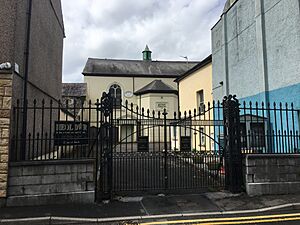Capel Heol Dŵr, Carmarthen facts for kids
Quick facts for kids Capel Heol Dŵr |
|
|---|---|
 |
|
| Location | Water Street, Carmarthen |
| Country | Wales, United Kingdom |
| Denomination | Calvinistic Methodist chapel |
| Architecture | |
| Heritage designation | Grade II |
| Designated | 19 May 1981 |
| Architectural type | Chapel |
| Style | Early 19th century |
| Closed | 2016 |
Capel Heol Dŵr was a special church building, called a chapel, located in Carmarthen, Wales. It belonged to a group of Christians known as Calvinistic Methodists. This chapel was built way back in 1831 on Water Street. It was recognized as a Grade II historic building on May 19, 1981, meaning it was important to protect. The chapel closed its doors in 2016.
Contents
The Chapel's Beginnings
How the Church Started
Calvinistic Methodists were active in Carmarthen starting around 1740. A group of them first met in a house on Goose Street. A very important person in starting the Water Street chapel was Peter Williams. He became a Methodist in 1743.
Peter Williams worked as a church assistant in different areas. However, he was not allowed to become a full priest because he was a Methodist. The very first chapel was built in the garden of a house he rented on Water Street.
Important Leaders
David Charles (1762–1834) was also connected to this chapel. He was the brother of Thomas Charles of Bala. In 1811, David Charles was one of 11 ministers who were officially recognized. This was against the wishes of the main Anglican church at the time. This event helped create the Calvinistic Methodist church group in Wales.
About the Chapel Building
What Capel Heol Dŵr Looked Like
Capel Heol Dŵr was one of the first Methodist chapels. The building you see today was built in 1831. The front of the chapel had two special entrances with columns. Above each entrance was a large arched window.
Inside the Chapel
Inside, the chapel had a gallery, which is like a balcony, shaped with five sides. The wooden seats, called box pews, were arranged to match the gallery. The chapel had a very unusual pulpit. A pulpit is where the minister stands to give a sermon. This one looked like a wine-glass with curved steps leading up to it.
A similar pulpit can be found in the nearby Capel Heol Awst, Carmarthen. These types of pulpits are rare now. They often disappeared when chapels were changed or made bigger. The ceilings inside Capel Heol Dŵr were made of wood and had a large plaster rose decoration. The chapel also had beautiful stained glass windows and several important monuments.
Changes Over Time
The chapel was updated in 1891 and again in 1922. During these updates, a new front was added, along with a new ceiling. A new area for the organ was also built in the middle of the front.
Why It Was a Listed Building
Capel Heol Dŵr was named a Grade II historic building on May 19, 1981. This was because it was a great example of an early 19th-century chapel. It still had its original inside parts, like the gallery from 1831. The Royal Commission on the Ancient and Historical Monuments of Wales keeps records of this church. These records include digital photos of the outside and inside of the building.
Later Years of the Chapel
New Churches Started
Over the years, three other churches were started as branches of Heol Dwr. These were Babell, Pensarn (in 1849), Zion, Carmarthen (in 1850), and Bethania, Carmarthen (in 1902).
Ministers and Members
In 1871, Reverend J. Lewis became the minister. It was said that 2,000 people attended his induction ceremony. In 1903, Reverend M.H. Jones became the minister and stayed for three years.
The Chapel Closes
In 2016, it was announced that the chapel would close. This was because the costs to keep it running were too high, and fewer people were attending. Broadcaster Huw Edwards supported a campaign to try and save the building. Like Heol Dwr, the Zion and Bethania chapels also closed around 2014 and 2015.

